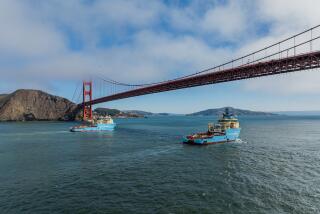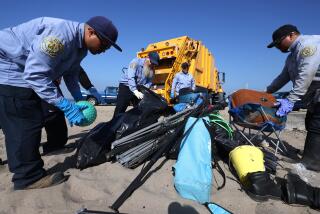EPA Proposes Sediment Dump Site Off Newport
Silt, sand and clay scraped from the ports of Los Angeles and Long Beach could be dumped in an underwater canyon off Newport Beach, under a federal proposal released Monday.
The proposal by the U.S. Environmental Protection Agency would allow 2.5 million cubic yards of sediment a year to be dumped off Newport Beach. A similar proposal would allow for 1 million cubic yards of sediment to be deposited at a site off Los Angeles.
And although the site off Newport Beach is proposed for 4.5 miles off the coast -- greatly diminishing chances for shore contamination, experts say -- environmentalists are worried the operation would harm sea life.
In addition, they say, the EPA has a poor track record of getting vessels to dump sediments at the actual site.
âThe primary risk isnât contaminated sediments; itâs really more dumping sediments inaccurately. Itâs happened,â said Mark Gold, executive director of Santa Monica-based Heal the Bay. âThere needs to be some strong assurances that thatâs going to be the dump place.â
The sediment would be collected from routine dredging operations in Los Angeles and Orange County marinas. The Los Angeles and Long Beach harbors require annual dredging to keep channels deep enough for boats.
EPA officials said that the limit of 2.5 million cubic yards a year was a high estimate and that the site could handle an additional half-million cubic yards.
EPA officials are planning for the possibility of simultaneous dredging of Upper Newport Bay and Los Angeles and Long Beach harbors, as well as Orange County marinas.
Officials also said federal guidelines maintained that only clean sediment could be deposited offshore.
âThereâs a testing program, and if it turns out thereâs an area that appears to be toxic, that area wonât be allowed to be taken out to the ocean,â said Allan Ota, oceanographer for the agencyâs San Francisco office.
The new dump location would be a permanent site, 6,000 feet wide and 1,500 feet beneath the waterâs surface. The underwater canyon is 1.3 miles southeast of a spot that has been used periodically as a repository for sediment dredged from Newport Bay and Dana Point Harbor.
In the proposalsâ environmental documents, which the public can comment on until March 7, the EPA concedes that a substantial amount of dredged material was found outside the boundaries of the interim site.
The same problem existed at the dump site off Los Angeles, critics said.
The dredging work is usually done by private contractors. EPA officials said that there were consequences for missing the spot.
âWeâve gotten a lot more sophisticated in monitoring in the last three years,â Ota said. âThe dredgers know that weâre watching.â
Ota said that new GPS trackers and sensors attached to sediment-laden barges would allow officials to track whether dredgers hauled their load to the appropriate site. Fines for imprecise dumping start at $55,000 per day, he said.
âThis [site] is out pretty deep, really nothing but a flat, muddy bottom,â Ota said. âThereâs nothing important in terms of resident fisheries or submerged reefs. And at that depth, many organisms are quite small.â
But Dennis Kelly, a professor of marine science at Orange Coast College in Costa Mesa, is skeptical that the dumping would have such limited effects on the environment.
âWeâre talking about a harbor area where thousands of boats pass through that are leaking highly toxic boat-bottom paints, theyâre leaking fuel, and itâs an area that receives constant runoff from the land,â Kelly said.
The ocean floor at the proposed site is flat-bottomed and dark most of the time, Kelly said. Itâs home to a variety of worms, clams, plankton and shrimp-like creatures and is a known feeding spot for fish during daylight hours.
âItâs not as eye-appealing as a kelp forest or Flipper, but it is important to our ecology out there,â Kelly said.
More to Read
Sign up for Essential California
The most important California stories and recommendations in your inbox every morning.
You may occasionally receive promotional content from the Los Angeles Times.










